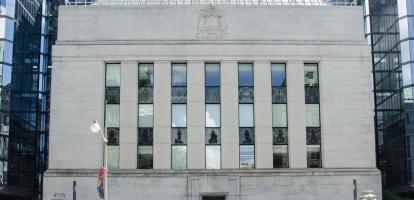At its last interest rate setting on March 8, the Bank of Canada paused its months-long hiking campaign and left unchanged its target for the overnight interest rate at 4.5 per cent. Being on the fence can be uncomfortable in the current inflationary environment – but for the latest rate setting on Wednesday, the bank was right to remain there.
Perching on the fence is uncomfortable for many reasons. First is the long lag time between setting interest rates and seeing the result. It can take 18 months or more for changes in interest rates to affect economic activity and then inflation. The bank’s rate hikes over the past year are moving inflation in the right direction. The year-over-year rate of inflation declined in February to 5.2 percent, well off its peak of 8.1 per cent in June, 2022. Still, all inflation measures remain well above the target.
Other signals for the inflation outlook are mixed. At the beginning of this year, the Bank of Canada estimated real annual GDP growth would be only 0.5 per cent in the first quarter. Subsequent data support an estimate of 1.5 per cent or more, meaning no significant slack opening that would put downward pressure on prices. The blockbuster employment increases of December, 2022, and January, 2023, have been followed by more modest increases in February and March but still, at an annual rate, the growth in employment over the past two months has been a robust 1.7 per cent.
All of these indicators, however, are precisely why the Bank of Canada was right to hold its interest rate on Wednesday. The bank’s Business Outlook Survey for the first quarter of 2023 revealed expectations of slower sales growth and an easing of labour shortages and wage growth pressures, despite the unemployment rate remaining low at about 5 per cent. The Survey of Consumer Expectations for the first quarter of 2023 revealed plans to spend less on discretionary items; inflation expectations have been lowered. The current pace of interest rate setting may prove appropriate to return to 2-per-cent inflation. We just need some time and considerable patience to get there.
The second factor making it difficult to remain on the fence is human behaviour – sensitivity to criticism that the bank is repeating a mistake. Having been criticized, together with other central banks, for leaving interest rates too low for too long, the bank will not relish any prospect of discovering in a year or two that it did not react strongly enough to rein in inflation pressures. But the decision to leave the policy rate unchanged in March suggested its willingness to take that chance. No significant signs of change in the economy’s robustness since then exist to merit altering that position, awkward though it may feel.
The third factor is a broader perspective on credit and financial variables that suggests conditions are not that tight. The target rate has increased 425 basis points (0.25 to 4.5 per cent) in a year – unprecedented. But other interest rates have not increased by nearly as much. Five-year to 30-year bonds yields are only around 3 per cent, in negative territory in real terms. On the other hand, some of the year-over-year growth rates in the central bank’s monetary aggregates have turned negative, suggesting a disinflationary impetus.
While sitting on the fence, it would be a good idea to do an intense examination of the consequences of the long period when the bank kept its policy rate at 2 per cent or lower, most of the time much lower, from December, 2008, to July, 2022. The current high inflation and wrenching economic dislocations to bring it back down are, in part, ramifications of this long easy monetary policy stance.
If and when the Canadian economy seems locked into a return to low, stable inflation, the Bank of Canada may be able to come off the fence and lower rates. But the rate cuts should be minor, returning the policy rate to a neutral stance, currently estimated at 2 to 3 per cent. Once there, bank officials should get back on their perch, and resist any temptation to again try to stoke the economy with easy money.
For the rest of us trying to decipher the Bank of Canada’s actions, we should pay more attention to the most recent inflation data and less to year-over-year measures, follow a broader range of financial and credit variables than the bank’s target rate, and compare interest rate levels more than their changes. That would lead us to spend less time speculating when the bank might lower its interest rate and focus on the warning in Wednesday’s rate decision that the bank “remains prepared to raise the policy rate further if needed to return inflation to the 2 per cent target.”
Don Drummond is a fellow-in-residence at C.D. Howe Institute and a Stauffer-Dunning Fellow at Queen’s University. He was formerly chief economist at Toronto-Dominion Bank and an associate deputy minister at Finance Canada.
Published in the Globe and Mail





